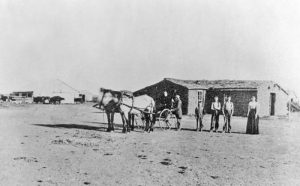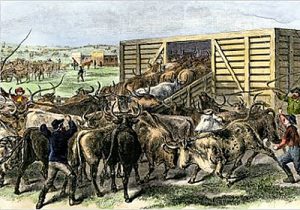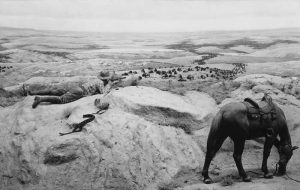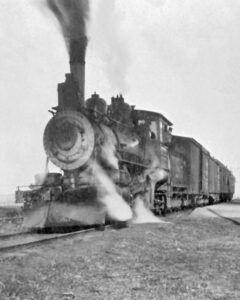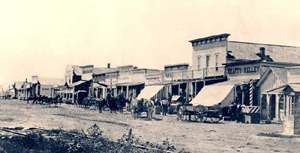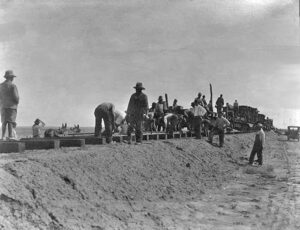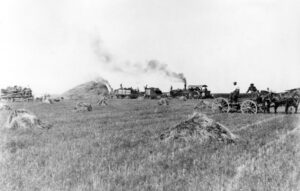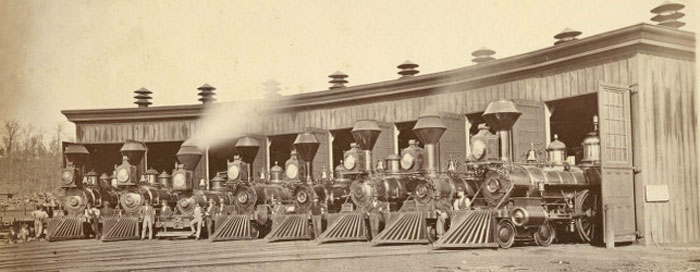
Kansas Pacific Railway Roundhouse.
1803 – The United States purchased the Louisiana Territory from France, starting a new settlement era for the Kanza Indian tribe.
1825 – Treaties between the federal government and the Kanza and Osage tribes.
1830 – The South Carolina Canal and Railroad Company operated the first American-built train. This was the era of transcontinental railroads in America. Over time, railroads would be built westward.
1850 – President Millard Fillmore signed the first railroad land-grant act. From then on, railroad transportation has been the most significant factor in the development of the western part of the United States.
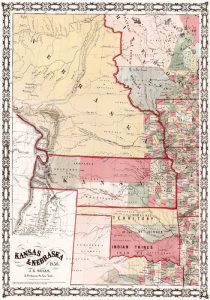
Kansas and Nebraska, 1856.
1854 – A purpose of the Kansas-Nebraska Act was to open the country to transcontinental railways to connect the east with the west. The pioneers questioned what Kansas offered: flat land, no trees, and snakes.
1855 – On February 1, the Leavenworth, Pawnee & Western Railroad was organized. It later became part of the Kansas Pacific Railroad.
1859 – The Capital of Kansas is Topeka, and Cyrus K. Holliday founded the Atchison, Topeka & Santa Fe Railway. The state of Kansas was named after the Kanza Indian tribe.
The state’s first railroad was a five-mile line built from Elwood to Wathena. Before railroads, people came by wagon train; they walked, rode horses, or rode the stagecoach. This new era of the steam railway was the threshold of transportation and the most significant era of expansion for the pioneers.
1860 – The first locomotive ran on the tracks laid on Kansas soil at Elwood. This locomotive and car were ferried up the Missouri River and placed on the track. The new age had come to Kansas. This was the future for travel and tourists.
1861 – Kansas became a state in the mid-central part of the United States. It is 411 miles from East to West and 208 miles from North to South, and Topeka is the Capital. Kansas has a large amount of land with a small population. The geographical center of the 48 contiguous states is Smith County, Kansas.
1862 – The land for the Homestead Act came from the railroads. The railroads were granted enormous acreage of federal land plus significant land endowments from the state. The railroad also purchased huge acreage “for a song” from the Indians.
The first train track surveyed across Kansas from east to west was the Kansas Pacific Railroad.
While the nation was engaged in civil war, President Abraham Lincoln signed the Pacific Railway Act into law, authorizing land grants and public funding for a transcontinental railroad to connect the East to the West. Two companies set to the task were Union Pacific Railroad, which started building west from Omaha, Nebraska, and the Central Pacific Railroad, which started building east from Sacramento, California.
On July 1, the Leavenworth, Pawnee & Western Railroad received a charter from the U.S. Congress to build a railroad and telegraph line from the Missouri River to the 100th meridian at Fort Riley, Kansas.
1863 – The locomotive engineers formed the first brotherhood union because they could not get insurance. The railroaders were the true settlers of the West.
On March 3, President Abraham Lincoln signed a land grant bill designating alternate sections to the Atchison, Topeka & Santa Fe Railroad.
On June 6, the Leavenworth, Pawnee & Western Railroad was renamed Union Pacific Railway, Eastern Division.
The Union Pacific Railway Eastern Division’s groundbreaking ceremony was held at Wyandotte (Kansas City, Kansas) on September 7.
On November 23, stockholders designated the Santa Fe Railway’s official name as the Atchison, Topeka, and Santa Fe Railway.
The first train track surveyed across Kansas from east to west was the Kansas Pacific Railroad. Construction began with the Ross and Steele firm from Canada in 1863. In 1864, the train was opened from Kansas City to Lawrence.
1864 – The unknown or unexpected battles of the prairies. This was the year that Native Americans began attacking the frontier settlers and the “iron horse.” They acknowledged that this horse (train) takes in water but eats wood. Only one set of railroad tracks was laid during this westward expansion.
On November 28, the first excursion train from Wyandotte (Kansas City) to Lawrence runs along 38 miles of track.
1865 – It was established that the railroads needed to be guarded because of the U.S. mail and to save lives. The railroad building over the Kansas flat plains should have been steady work, but the workers had many hard times with nature, heat, being dry, wind-dust storms, floods, the cold, and snow.
1866 – In June, the Union Pacific Railway, Eastern Division, reached Junction City.
On July 3, Congress authorized the Union Pacific Railway, Eastern Division, to build from Fort Riley to Denver, Colorado, and then join the Union Pacific near Cheyenne, Wyoming.
1867 to 1872 – Over three million head of Texas longhorn cattle were driven to the Kansas Pacific Railroad for shipment at the center of Abilene. When the cowboys had their herds safely inside the loading corrals, they were ready to celebrate. The Wild West town of Abilene had saloons for gambling and drinking in dance halls.
1867 – Rifles were issued to the workers as part of the equipment to protect themselves against attacks and buffalo stampedes.
In March, the Union Pacific, Eastern Division, crossed the Solomon River.
On April 16, the Union Pacific, Eastern Division, crossed the Salina River.
On October 1, the Union Pacific Railway, Eastern Division, reached Ellsworth, Kansas, a distance of 224 miles.
On October 14, the Union Pacific Railway, Eastern Division, reached Hays, a distance of 260 miles.
On November 1, the Leavenworth, Lawrence & Galveston Railroad crossed the Kansas River at Lawrence.
1868 – The Union Pacific Railway, Southern Branch, or the Missouri, Kansas & Texas Railway (KATY) construction begins at Junction City.
In August, the Cimarron Route was abandoned.
On August 22, the Union Pacific Railway, Eastern Division, reached Sheridan in Wallace County, a distance of 406 miles.
On October 30, the first spade of earth was turned, beginning construction on the Atchison, Topeka & Santa Fe Railroad.
1869 – The Atchison, Topeka, and Santa Fe Railroad was the first railroad built across Kansas from north to south.
The problem of obtaining food for the laborers was solved by contracting hunters to keep a supply of fresh buffalo meat on hand.
The most prominent performer of this important service was William F. Cody, who, as a result of his work, received the famous title of “Buffalo Bill.” The railroad’s importance was realized as the horde of land settlers went West.
On March 3, the Union Pacific Railway’s Eastern Division changed its name to Kansas Pacific Railway.
The first Atchison, Topeka & Santa Fe Railroad excursion was made from Topeka to Wakarusa in April.
On May 10, 1869, the Union Pacific Railroad and the Central Pacific Railroad met at Promontory Point, now the Golden Spike National Historic Park, in Utah.
On September 18, the Atchison, Topeka & Santa Fe Railroad reached Burlingame.
In October, the Kansas Pacific Railway construction resumed westward from Sheridan.
1870 – The Kansas-Pacific Railway reached the Kansas-Colorado border with its tracks in March.
In June, the Missouri, Kansas & Texas Railway was the first railroad built to the Kansas-Oklahoma border.
In July, the Atchison, Topeka & Santa Fe Railroad reached Emporia.
On August 15, the Kansas Pacific and Denver Pacific meet at Comanche Crossing, a distance of 602 miles.
On September 1, the Kansas Pacific Railway service to Denver, Colorado, began.
On October 3, the Kansas Pacific Railway reached downtown Denver’s passenger depot.
1871 – In March, a line from Sedalia, Missouri, to Fort Scott, Kansas, connected with the Missouri, Kansas & Texas Railway in the new community of Parsons, Kansas.
On July 17, the Atchison, Topeka & Santa Fe Railroad reached Newton, Kansas.
In October, the Missouri, Kansas & Texas Railway reached Fort Gibson, Indian Territory (Oklahoma).
1872 – An Atchison, Topeka & Santa Fe Railroad branch arrived at Wichita, and the town “busted wide open.” A sign was erected at the outskirts of the town proclaiming: “Everything goes in Wichita.” Many parade celebrations with fireworks commenced when the railroad tracks reached a town. Every village was enthusiastic about the railroad because it would become a distributing center if a town got a railroad. The goal of the site was to obtain more than one railroad to radiate from the town.
When the Atchison, Topeka & Santa Fe Railway reached the Colorado border, people started using the railroad to transport goods and materials from one settlement to another. The Santa Fe Trail was no longer the main transportation route.
On May 16, the Atchison, Topeka & Santa Fe Railroad connected Atchison and Topeka.
On June 8, the Atchison, Topeka & Santa Fe Railroad reached Hutchinson, considered the end of the track, but construction continued.
The Atchison, Topeka & Santa Fe Railroad reached Dodge City in September.
On December 25, the Missouri, Kansas, & Texas Railroad reached the Red River and Denison, Texas, with a new route to the Gulf.
On December 28, the Atchison, Topeka & Santa Fe Railroad reached the Kansas-Colorado border ahead of its March 3, 1873, deadline.
1873 – In July, the Atchison, Topeka & Santa Fe Railroad reached old Granada, Colorado
1874 – Four railroads shipped over 122,900 head of Texas cattle in eight months to Kansas.
1876 – In November, the Kansas Pacific Railway was in receivership.
1878 – The first track abandonment was the 13.5-mile Saint Joseph & Topeka Railway between Wathena and Doniphan.
1878 to 1879 – With the purchased land from the Kansas Pacific Railroad, several hundred River Brethren from Pennsylvania came to the cowtown of Abilene in Dickinson County. They brought carloads of household items, farming equipment, and more than half a million dollars in cash. At once, they began to organize homes and fields for farming on the plains. Everyone wanted to move West to a good country. An estimated 55,000 immigrants from England, Germany, Russia, and Sweden came to Kansas.
1879 – On March 7, Jay Gould and associates with the Union Pacific agreed to purchase a controlling interest in the Kansas Pacific Railway
1880 – On January 24, the Kansas Pacific Railway merged with the Union Pacific Railroad and Denver Pacific Railway to form the Union Pacific Railway. The steel highway was history now, with the following words describing the railroad. “It was a hastily constructed highway which cost three times as much as it was worth and yet was worth many times more than three times as much as it cost.” The Kansas-Pacific Railroad played a key role in the economy of Kansas and the United States. On the same date, the
1880s – The bulk of the rail was laid, and the population of Kansas had increased to almost one million compared to the 100,000 twenty years before. Most of the people lived on the eastern side of the state. The movement of the settlers into the West was due to the railroad expansion. Locomotives were now being built in Atchison, Topeka, and other cities in Kansas.
1881 – Many of the trail herds headed for Dodge City, a shipping point on the Atchison, Topeka & Santa Fe Railway.
1883 – The railroads adopted Standard railroad gauges.
The Railroad Act established a regulatory commission on general rate schedules.
Almost 500 carloads of coal are shipped each month out of Litchfield, just northeast of Pittsburg in Crawford County.
1885 – The last Texas cattle drive to Dodge City in Ford County.
1886 – A person could obtain a charter to build any railroad anywhere by asking for a charter and paying one dollar. Over 40 railroad companies were chartered during the territorial period in hopes of becoming a branch of the transcontinental route in Kansas.
1887 – The first federal act was the Interstate Commerce Act to regulate passenger rates.
1900 – Over 70 Hispanics came to Kansas as laborers for various Railroad companies.
1911 – Heavy snow over the state tied up railroad transportation.
1914 – With 12 railroad lines entering the city, Kansas City built one of the largest railroad stations in the country. The main building covered 15 acres. A system of tracks, built below the street level to Union Station, cost $50 million. Kansas City became a chief railroad junction for the Central Mid-states.
1917 – The State of Kansas had its longest miles of track, totaling 9,367 miles, with 26 different railroads in each county.
1926 – Congress passed the Railway Labor Act to help avoid significant strikes that might endanger the economy or create a national emergency.
1930 – The last ethnic group of 19,402 Hispanics to enter Kansas as laborers for various Railroad companies.
1931– Kansas’s record wheat crop of 240 million bushels, most of which were shipped by rail, was harvested this year.
1951 – The flood of 1951 stopped railroad transportation. Do they rebuild or not?
1961 – The world’s largest and longest wheat elevator is located at Hutchinson in Reno County, our nation’s primary challenging wheat market. Kansas is known as the grain state, and we ship the majority of it out by rail.
1969 – Sixteen railroad lines operate over 8,000 miles of track in Kansas. Over a third of the track belongs to the Atchison, Topeka, and Santa Fe Railroad.
1986 – Kansas produced 421,540,000 wheat bushels, most of which were shipped by rail.
1993 – Floods in June and July damaged railroads and bridges statewide and in many parts of the upper Midwest.
1995 – The Atchison, Topeka, and Santa Fe Railway and the Burlington Northern and Santa Fe Railway merged. Effective in 1997, it is now called BNSF.
1999 – Kansas railroads serve all but two counties with at least one railroad line in each county.
2000 – The merger between the railroads, Burlington Northern Santa Fe Corporation, and Canadian National Railway Company will not occur this year.
In the past decade, railroading has experienced many changes. Lines have been abandoned, corporate mergers and sales have taken place, and familiar railroad names have disappeared.
2001 – On June 29, the Class III Railroad company Central Kansas Railway was sold to the Kansas & Oklahoma Railroad. The K & O started operating the railroad line at 12:01 A.M. on June 30.
Compiled and edited by Kathy Alexander/Legends of Kansas, updated September 2025.
Also See:
A Century of Railroad Building
Sources:

